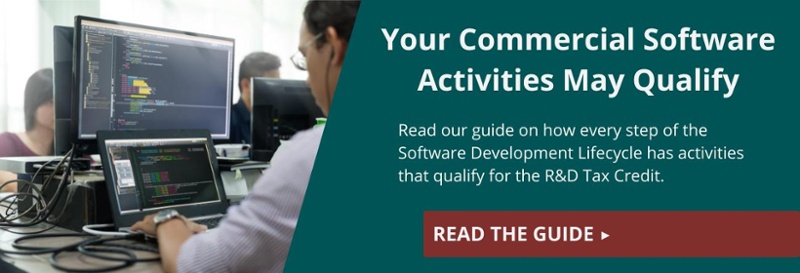
For either consumer use or internal use, deploying new software can feel like a welcome conclusion. Especially when you think of claiming R&D Tax Credits, right?
Well, not so fast! The R&D Tax Credit was designed to encourage companies to not only develop new products and processes, but also to improve existing products and processes; all to give you an edge in a competitive market.
Doing any software maintenance?
Enhancing existing software?
There could be R&D Tax Credits available to help offset the cost of this work. You just need to determine the Qualified Research Expenses (QREs) found within a software development project’s numerous phases. Software development typically happens in seven main phases, often called the software development lifecycle (SDLC).
This article focuses on specific activities within the final phase: software maintenance and enhancements. Discover what activities may qualify as well as tips for a thorough claims process.
Maintenance and Enhancements
The final step of the SDLC relates to the continued evolution of the system. To meet changing and evolving user needs over time, enhancements should be made that often relate to improved performance, new functions, features, or capabilities. Those are the types of activities that usually qualify for R&D Tax Credits.
Here are some examples of ongoing activities that would NOT qualify:
- Routine post-production support
- Ongoing technical updates
- Bug fixes
- Cosmetic changes
- Developing user documentation
It’s important to be thinking in terms of “enhancements” vs. “maintenance.” Depending on the size and scope of the enhancement effort, some or all of the SDLC seven phases of development may occur.
What are software maintenance activities? What are software enhancement activities? Qualifying activities likely include planning, requirements gathering, design, and testing activities. These are the core activities to focus on when looking for QREs.
Apply The Four-Part Test
Once you’ve identified potential qualifying activities for R&D Tax Credits, verify them by applying the four-part test:
- Permitted Purpose. This is the activity intended to make or improve either a product or process that results in improved function, performance, reliability, quality, or cost efficiency.
- Technical Uncertainty. This is the activity intended to eliminate technical uncertainty when developing or improving a product or process related to methodology, design, techniques, formulas, or inventions.
- Process of Experimentation. This is the activity that includes a process of experimentation to eliminate or resolve technical uncertainty. During the process, various alternatives and approaches are evaluated by modeling, simulation, trial and error, prototyping, and other methods.
- Technological in Nature. The process of experimentation must rely on the hard sciences (engineering, physics, biology, chemistry, computer science).
Ask a Specialist
The smart way to ensure you’re getting the full value from your software maintenance and software enhancement efforts is to ask for expert R&D Tax Credit help.
In order to maximize your return on investment in software development, work with a professional tax adviser throughout this complex process. It’s the best way to ensure a thorough and accurate claim is prepared for filing. Black Line Group is here to help your business be even more profitable.





